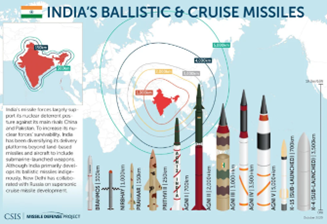TAG: GS-3: SCIENCE AND TECHNOLOGY
THE CONTEXT: India announced the successful flight test of its first long-range hypersonic missile on November 17, 2024. It was flight-tested by the Defence Research and Development Organisation (DRDO) from Dr APJ Abdul Kalam Island off the Odisha coast late last night.
What is a Hypersonic Missile?
- Hypersonic missiles are advanced weapons that travel at speeds exceeding Mach 5 (five times the speed of sound) and are known for their maneuverability and ability to evade traditional missile defense systems.
- The maneuverability of the hypersonic missile is what sets it apart from a ballistic missile as the latter follows a set course or a ballistic trajectory. Thus, unlike ballistic missiles, hypersonic missiles do not follow a ballistic trajectory and can be maneuvered to the intended target.
- They fly at lower altitudes than ballistic missiles, making them harder to track.
- Their extreme speed and maneuverability make them very difficult to defend against.
- The two types of hypersonic weapons systems are Hypersonic Glide Vehicles (HGV) and Hypersonic Cruise Missiles (HCM).
- The HGV are launched from a rocket before gliding to the intended target while the hypersonic cruise missile is power
Key Features of India’s Hypersonic Missile
-
- Speed and Range: The missile can achieve speeds of over Mach 5, offering quick response capabilities against potential threats.
- Manoeuvrability: Its advanced design allows it to change trajectory mid-flight, making interception challenging for adversaries.
- Versatility: Hypersonic missiles can deliver both conventional and nuclear warheads, making them strategic deterrents.
- Precision: Equipped with advanced guidance systems, they ensure high accuracy even at long ranges.
What are the advantages of hypersonic missiles?
- They can enable responsive, extended-range strike options against distant, defended or time-critical threats (such as road-mobile missiles) when other forces are unavailable, denied access, or not preferred. Conventional hypersonic weapons use only kinetic energy, i.e. energy derived from motion, to destroy unhardened targets or even underground facilities.
- Hypersonic weapons can challenge detection and defence due to their speed, manoeuvrability and low flight altitude.
- Ground-based or terrestrial radars can only detect hypersonic missiles late in the weapon’s flight.
- This delayed detection makes it difficult for the responders to the missile attack to assess their options and to attempt to intercept the missile.
Types of Missiles in India:
- Subsonic missile: Missiles that travel slower than sound is known as “subsonic.”
- U. S. BGM-109 Tomahawk long-range subsonic cruise missile, Indian Nirbhay subsonic cruise missile.
- Supersonic missile: Missiles that travel faster than the speed of sound (Mach 1) but less than Mach 5 are called “supersonic.”
- BrahMos:Joint Indo-Russian BrahMos is the fastest supersonic cruise missile reaching close to Mach 3 speed.
- Hypersonic missile: The term “hypersonic” means that the speed of missiles should be at least five times faster than the speed of sound (over Mach 5).

-
- Cruise missiles powered using scramjet engines to realise speeds greater than Mach 5 are designated as hypersonic cruise missiles.
- 3M22 Zircon: Russia’s 3M22 Zircon can fly over Mach 8 as a hypersonic cruise missile.
- BrahMos II: Said to be based on Zircon, BrahMos Aerospace is working on the BrahMos-II variant to attain hypersonic cruise speeds above Mach 8.
- Cruise missiles powered using scramjet engines to realise speeds greater than Mach 5 are designated as hypersonic cruise missiles.
What is the Indian Hypersonic Missile Programme?
- India is also developing an Indigenous, dual-capable (conventional and nuclear) hypersonic cruise missile as part of its Hypersonic Technology Demonstrator Vehicle Programme. It has successfully tested a Mach 6 scramjet in June 2019 and September 2020. India operates approximately 12 hypersonic wind tunnels and can test speeds up to Mach 13.
Which countries have hypersonic weapons?
- While the US, Russia and China are in advanced stages of hypersonic missile programmes, India, France, Germany, Japan and Australia too are developing hypersonic weapons.
Source:
Spread the Word
